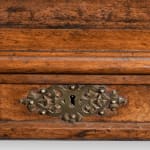Gothic Revival Walnut Writing Table, attributed to Crace & Co.
ENGLAND, CIRCA 1860
75.9 x 137.2 x 67.9 cm
30 x 54 x 26 ¾ in
30 x 54 x 26 ¾ in
6866
Further images
-
(View a larger image of thumbnail 1
)

-
(View a larger image of thumbnail 2
)

-
(View a larger image of thumbnail 3
)

-
(View a larger image of thumbnail 4
)

-
(View a larger image of thumbnail 5
)

-
(View a larger image of thumbnail 6
)

-
(View a larger image of thumbnail 7
)

-
(View a larger image of thumbnail 8
)

-
(View a larger image of thumbnail 9
)

The design in the manner of Edward. W. Pugin. The top originally having an inset tooled leather writing surface (the leather tooling marks still visible in the surface of the...
The design in the manner of Edward. W. Pugin. The top originally having an inset tooled leather writing surface (the leather tooling marks still visible in the surface of the wood), over two shallow drawers with decorative escutcheons by John Hardman & Co. of Birmingham and locks by Hobbs & Co., London; supported on two shaped x-form supports with carved four-petal floral motifs and floral roundels to the centre, feet and stretcher.
This form of table can be seen in gothic revival furniture going back to A.W.N. Pugin, whose designs for St. Chad’s Cathedral, Birmingham show a table with similarly decorated x-form supports. The fittings for St. Chad’s Cathedral were mostly made by John Hardman & Co.
John Hardman & Co.: was an ornamental metalwork manufacturer. In 1837 John Hardman Senior (1766–1844) had his own business, inherited from his father, a manufacturer of metal buttons. He met A. W. N. Pugin (1812–1852) in 1838 in Birmingham and began producing metalwork to Pugin’s designs, beginning with works in The Cathedral of St. Chad in Lichfield. John Hardman Senior died in 1844. By then the younger John Hardman was head of the firm. Collaboration with A.W.N. Pugin continued and from 1845 the business also began to make stained glass.
Hobbs & Co. were lockmakers established in 1851 by Alfred Charles Hobbs, an American who visited London to take part in the 1851 Great Exhibition. Based in Cheapside, he brought mass production techniques into the industry and also exhibited at the1855 Paris Exhibition.
Crace & Co., (fl.1768-1899) London were interior decorators, designers and furniture makers who specialised predominantly in gothic style furniture based on the designs of Augustus Welby Pugin (1812-52). Their workshops, established in 1844 were behind the company showrooms on Wigmore Street.
A table of similar form, construction and decoration designed by A.W.N. Pugin for Horsted Place can be found in the collection at the Victoria & Albert Museum, London (W.26-1972). The item entry states ‘This form of pegged construction and the X-frame bracing became, during the 1840s, two of the most significant and exciting of Pugin's innovations in furniture design and can be seen in the surviving pieces supplied by Webb for the House of Lords.’
This form of table can be seen in gothic revival furniture going back to A.W.N. Pugin, whose designs for St. Chad’s Cathedral, Birmingham show a table with similarly decorated x-form supports. The fittings for St. Chad’s Cathedral were mostly made by John Hardman & Co.
John Hardman & Co.: was an ornamental metalwork manufacturer. In 1837 John Hardman Senior (1766–1844) had his own business, inherited from his father, a manufacturer of metal buttons. He met A. W. N. Pugin (1812–1852) in 1838 in Birmingham and began producing metalwork to Pugin’s designs, beginning with works in The Cathedral of St. Chad in Lichfield. John Hardman Senior died in 1844. By then the younger John Hardman was head of the firm. Collaboration with A.W.N. Pugin continued and from 1845 the business also began to make stained glass.
Hobbs & Co. were lockmakers established in 1851 by Alfred Charles Hobbs, an American who visited London to take part in the 1851 Great Exhibition. Based in Cheapside, he brought mass production techniques into the industry and also exhibited at the1855 Paris Exhibition.
Crace & Co., (fl.1768-1899) London were interior decorators, designers and furniture makers who specialised predominantly in gothic style furniture based on the designs of Augustus Welby Pugin (1812-52). Their workshops, established in 1844 were behind the company showrooms on Wigmore Street.
A table of similar form, construction and decoration designed by A.W.N. Pugin for Horsted Place can be found in the collection at the Victoria & Albert Museum, London (W.26-1972). The item entry states ‘This form of pegged construction and the X-frame bracing became, during the 1840s, two of the most significant and exciting of Pugin's innovations in furniture design and can be seen in the surviving pieces supplied by Webb for the House of Lords.’









